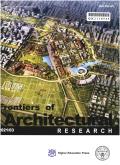Contemplative neuroaesthetics in architecture: A real-world mobile EEG study in the ancient city of Ghardaïa, Algeria
IF 3.6
1区 艺术学
0 ARCHITECTURE
引用次数: 0
Abstract
This study investigates the potential of built environments to induce contemplative states, contributing to the emerging field of contemplative neuroaesthetics. While the psychological benefits of these states are well-documented, their relationship with architecture remains underexplored. Using an embodied cognition framework, we explore how architectural features engage the sensorimotor system, fostering contemplative experiences. The ancient city of Ghardaïa, known for its natural harmony and subtle aesthetics, was the case study. Twenty participants, with no prior exposure to the site or architectural background, took part in a real-world experiment. They followed a designated path while equipped with a 32-channel mobile EEG system, smart band, and wide-angle cameras. Subjective feedback was collected via questionnaires. Multiple linear regression revealed that curved pathways significantly reduced Default Mode Network (DMN) activity (), suggesting heightened sensorimotor engagement, potentially inducing a contemplative state. Conversely, higher occlusivity, measured through space syntax, correlated with increased DMN activity (; ), indicating enclosed spaces promote introspection. Architectural features like corbels, arches, and landmarks also influenced DMN activity, highlighting spatial elements’ role in shaping brain dynamics. Future research should examine architectural contexts to clarify these mechanisms, with implications for designing spaces that promote well-being.
建筑中的沉思神经美学:阿尔及利亚古城Ghardaïa的真实世界移动脑电图研究
本研究探讨了建筑环境诱导沉思状态的潜力,为沉思神经美学的新兴领域做出了贡献。虽然这些状态的心理好处是有据可查的,但它们与建筑的关系仍未得到充分探讨。使用具身认知框架,我们探索建筑特征如何参与感觉运动系统,促进沉思体验。以自然和谐和微妙的美学而闻名的古城Ghardaïa是研究的案例。20名参与者没有事先接触过场地或建筑背景,参加了现实世界的实验。他们在指定的路径上行走,并配备了32通道移动脑电图系统、智能腕带和广角摄像头。通过问卷调查收集主观反馈。多元线性回归显示,弯曲路径显著降低了默认模式网络(DMN)的活性(β= - 0.064;p<0.0001),表明感觉运动参与增强,可能诱发沉思状态。相反,通过空间句法测量的高闭塞度与DMN活性增加相关(β=0.153;P =0.009),表明封闭的空间促进内省。建筑特征,如屋梁、拱门和地标也会影响DMN的活动,突出了空间元素在塑造大脑动态中的作用。未来的研究应该检查建筑背景,以澄清这些机制,并对设计促进福祉的空间产生影响。
本文章由计算机程序翻译,如有差异,请以英文原文为准。
求助全文
约1分钟内获得全文
求助全文
来源期刊

Frontiers of Architectural Research
ARCHITECTURE-
CiteScore
6.20
自引率
2.90%
发文量
430
审稿时长
30 weeks
期刊介绍:
Frontiers of Architectural Research is an international journal that publishes original research papers, review articles, and case studies to promote rapid communication and exchange among scholars, architects, and engineers. This journal introduces and reviews significant and pioneering achievements in the field of architecture research. Subject areas include the primary branches of architecture, such as architectural design and theory, architectural science and technology, urban planning, landscaping architecture, existing building renovation, and architectural heritage conservation. The journal encourages studies based on a rigorous scientific approach and state-of-the-art technology. All published papers reflect original research works and basic theories, models, computing, and design in architecture. High-quality papers addressing the social aspects of architecture are also welcome. This journal is strictly peer-reviewed and accepts only original manuscripts submitted in English.
 求助内容:
求助内容: 应助结果提醒方式:
应助结果提醒方式:


